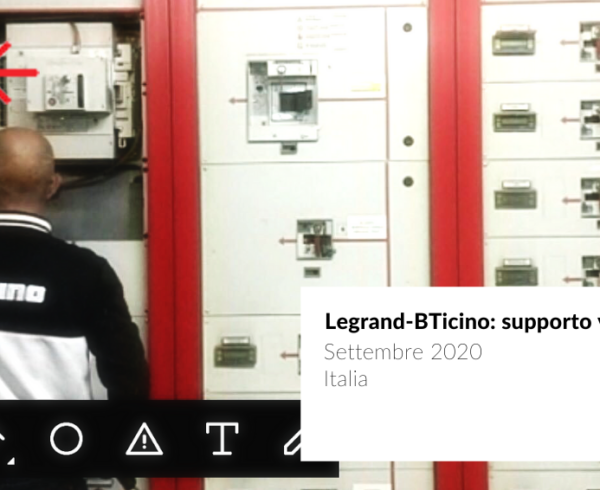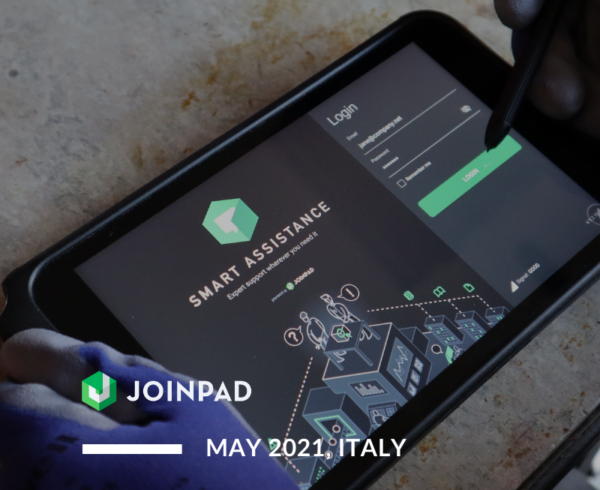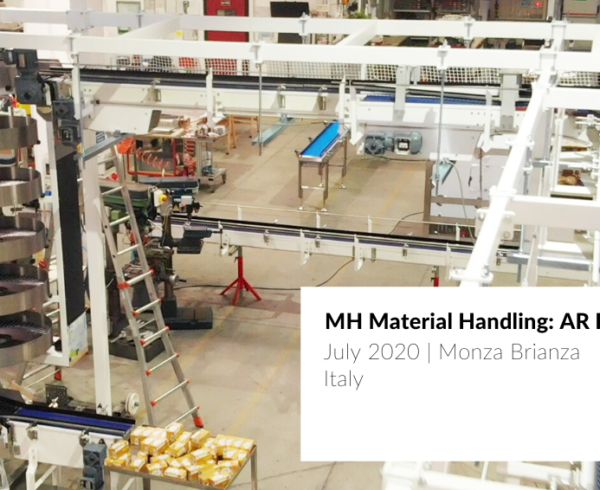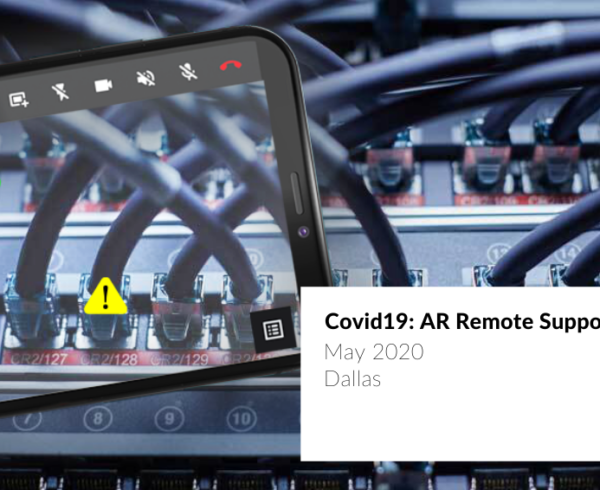

The digital transformation of the Field Service
Services are acquiring an increasingly central role across industries, allowing companies to achieve higher margins than merely selling the physical product while strengthening the customer-supplier relationship and ensuring lasting collaboration. To perform at its best, the company services system – also known as Smart Service – must be connected to an efficient digital infrastructure supporting data-based decisions, enhancing timely maintenance and support interventions, as well as creating a virtuous cooperative circle with stakeholders.
One of the enabling technologies of the Smart Service model in industrial contexts is Augmented Reality, which allows expert technicians to remotely support operators in the field during the maintenance, plant start-up, industrial equipment testing, and customer assistance processes.
The importance of having a solid digital structure emerged strongly during the COVID-19 pandemic that forced the temporary closure of most of the global activities. Some companies, already oriented towards technological innovation, not only guaranteed operational continuity during the lockdown but are quickly adapting to the post-COVID world thanks to innovative solutions that make business processes safer, more efficient, and resilient.
For several years, JoinPad has collaborated with BTicino to transform assistance processes, allowing experts to guide on-field technicians through a remote “virtual eye.” The Augmented Reality platform enables you to optimize field service operations, drastically reducing problem resolution time and intervention costs thanks to fewer field service trips at the user’s location.
The digital transformation of the Field Service
Services are acquiring an increasingly central role across industries, allowing companies to achieve higher margins than merely selling the physical product while strengthening the customer-supplier relationship and ensuring lasting collaboration. To perform at its best, the company services system – also known as Smart Service – must be connected to an efficient digital infrastructure supporting data-based decisions, enhancing timely maintenance and support interventions, as well as creating a virtuous cooperative circle with stakeholders.
One of the enabling technologies of the Smart Service model in industrial contexts is Augmented Reality, which allows expert technicians to remotely support operators in the field during the maintenance, plant start-up, industrial equipment testing, and customer assistance processes.
The importance of having a solid digital structure emerged strongly during the COVID-19 pandemic that forced the temporary closure of most of the global activities. Some companies, already oriented towards technological innovation, not only guaranteed operational continuity during the lockdown but are quickly adapting to the post-COVID world thanks to innovative solutions that make business processes safer, more efficient, and resilient.
For several years, JoinPad has collaborated with BTicino to transform assistance processes, allowing experts to guide on-field technicians through a remote “virtual eye.” The Augmented Reality platform enables you to optimize field service operations, drastically reducing problem resolution time and intervention costs thanks to fewer field service trips at the user’s location.
BTicino: Augmented Reality Remote Support in the electrical sector
BTicino, part of the Legrand Group, is the global specialist for the electric and digital infrastructures of buildings. For the design of its exclusive command and control interfaces and home automation, it has always been one of the most recognized protagonists of Made in Italy in over 60 countries worldwide.
The goal of “developing permanent innovation in all fields” is continuously pursued by the numerous R&D teams within the group, focusing on Industry 4.0 technologies such as Augmented Reality and Artificial Intelligence.
In 2018, with the collaboration of the Innovation Team, the Electrical Infrastructure business unit started a project to find a solution that would encourage remote assistance, assessing the opportunities that Augmented Reality offered as an emerging technology. The goal was to make the after-sales assistance services in the industrial sector more efficient for power products, such as components installed in electrical panels.
Sometimes, it happened to send expert technicians to remote places, which usually required several days of travel, to provide technical assistance during maintenance procedures, only to discover that the problem could be solved by giving simple indications to local operators.
After a period of searching for various solutions, the team chose JoinPad to build a suitable platform for the remote support needs of BTicino, including AR video streaming in real-time. Starting with the standard version of Smart Assistance, the collaboration turned into a real co-creation project of an advanced digital tool, customized with the colors and the Legrand logo and branded Smart Support.

Smart Support, a custom version of Smart Assistance for Legrand-BTicino. Source: JoinPad
The tool allows you to provide remote assistance anywhere in the world. In addition to the ability to exchange files, the photo-sharing mode has been added to interact using only images in case of poor connectivity, a frequent situation in this sector. Indeed, for safety and protection reasons, switches are often put in armored places, difficult to access, where the network connection is low or works intermittently. This feature can also be used to allow the operator to work hands-free. “When I have to intervene on a breaker panel, I can switch to” photo sharing “mode and put the phone down: the remote expert can show me the steps I need to take in sequence in real-time on the image. I don’t have the view of the virtual elements superimposed, but a clear guide “, explains the Innovation Leader, Lorenzo Pini, who coordinated the project. The integrated CMS – the content and intervention history management system– allows easy access to the list of calls, images, and documents exchanged.
Smart Support is currently distributed across the Legrand-BTicino Android and iOS channel, available to technicians who must carry out interventions on the plants, with the goal of spreading its adoption widely within the group at an international level.
Smart Support has been made available in Europe, the USA, China, and India. The activity being carried out is to verify the various solutions and an attempt to converge these large-scale applications within Legrand.
– Lorenzo Pini
BTicino’s approach to a remote assistance solution in AR is based on a fundamental condition, namely the need for the technician in the field to receive visual support. The project leader explains, “If by equipping the remote operator with a” virtual eye,” he/she can understand the problem, identify it or do an analysis, then the solution can be useful and effective. Where I have to identify an electronic/electrical issue, it is probably not enough for me to see, but I will have to use other tools as well. ”

The remote expert uses Smart Support to guide the operator in the field during the maintenance of an electrical panel.
In general, many companies choose to carry out support processes by using the tools they already have, such as email, phone calls, and the most popular messaging applications. The result often translates into the expert’s visit on site, as these solutions have not been developed to facilitate remote technical interventions. Not only does it become hard to identify what the problem is through simple messages and photos, but the whole procedure could go on for weeks, generating a considerable waste of human and economic resources. “The whole process triggers then a long flow of information exchange,” underlines Lorenzo Pini.
We suggest replace the exchange of emails by activating the “digital eye” for problems that can be identified using remote viewing. This way we believe we can free up time for assistance. This is our goal.
The application, developed in collaboration with JoinPad, has been used by BTicino mainly after the post Coronavirus emergency, proving to be among the most effective tools for providing remote technical assistance in compliance with the rules on social distancing.
To give some significant examples, Smart Support was instrumental in solving a problem with an industrial switch that had been giving the technical team a hard time for ten days. After resorting to the traditional exchange of information via email or telephone, it was finally decided to use the Augmented Reality platform. The issue was discovered and solved in about half an hour. Similarly, the understanding of a defect on a testing machine designed by BTicino and distributed at one of its factories was speeded up.

Smart Support on Samsung Tab Active 2 and AR Widgets. Source: JoinPad
To conclude with a further example, close to the end of the lockdown, Smart Support was particularly useful during the commissioning of a production line in a European country. Through the live video stream and indications in Augmented Reality, the operation was successfully completed, even remotely.
Thanks to Smart Support, BTicino is not only simplifying its remote support processes but is also gaining significant efficiencies of scale in the service sector linked to a strong reduction in intervention resolution times and travel expenses.
“Thanks to the experience gained in building remote assistance tools and the continuous dialogue with the BTicino team, we were able to create a product capable of meeting the needs of the sector and improving a support process which, without Smart Support, was often fragmented and not very optimized. We enjoyed working with people who have shown great willingness to collaborate and out-of-the-ordinary proactiveness, sharing a lot of information to improve the product. This experience has helped us to increase our respective skills, projecting ourselves towards new ideas that will give life to further functionalities and consolidate the collaboration between our two realities ”, concludes Giuseppe Audino, Chief Technology Officer of JoinPad.
BTicino: Augmented Reality Remote Support in the electrical sector
BTicino, part of the Legrand Group, is the global specialist for the electric and digital infrastructures of buildings. For the design of its exclusive command and control interfaces and home automation, it has always been one of the most recognized protagonists of Made in Italy in over 60 countries worldwide.
The goal of “developing permanent innovation in all fields” is continuously pursued by the numerous R&D teams within the group, focusing on Industry 4.0 technologies such as Augmented Reality and Artificial Intelligence.
In 2018, with the collaboration of the Innovation Team, the Electrical Infrastructure business unit started a project to find a solution that would encourage remote assistance, assessing the opportunities that Augmented Reality offered as an emerging technology. The goal was to make the after-sales assistance services in the industrial sector more efficient for power products, such as components installed in electrical panels.
Sometimes, it happened to send expert technicians to remote places, which usually required several days of travel, to provide technical assistance during maintenance procedures, only to discover that the problem could be solved by giving simple indications to local operators.
After a period of searching for various solutions, the team chose JoinPad to build a suitable platform for the remote support needs of BTicino, including AR video streaming in real-time. Starting with the standard version of Smart Assistance, the collaboration turned into a real co-creation project of an advanced digital tool, customized with the colors and the Legrand logo and branded Smart Support.

Smart Support, a custom version of Smart Assistance for Legrand-BTicino. Source: JoinPad
The tool allows you to provide remote assistance anywhere in the world. In addition to the ability to exchange files, the photo-sharing mode has been added to interact using only images in case of poor connectivity, a frequent situation in this sector. Indeed, for safety and protection reasons, switches are often put in armored places, difficult to access, where the network connection is low or works intermittently. This feature can also be used to allow the operator to work hands-free. “When I have to intervene on a breaker panel, I can switch to” photo sharing “mode and put the phone down: the remote expert can show me the steps I need to take in sequence in real-time on the image. I don’t have the view of the virtual elements superimposed, but a clear guide “, explains the Innovation Leader, Lorenzo Pini, who coordinated the project. The integrated CMS – the content and intervention history management system– allows easy access to the list of calls, images, and documents exchanged.
Smart Support is currently distributed across the Legrand-BTicino Android and iOS channel, available to technicians who must carry out interventions on the plants, with the goal of spreading its adoption widely within the group at an international level.
Smart Support has been made available in Europe, the USA, China, and India. The activity being carried out is to verify the various solutions and an attempt to converge these large-scale applications within Legrand.
– Lorenzo Pini
BTicino’s approach to a remote assistance solution in AR is based on a fundamental condition, namely the need for the technician in the field to receive visual support. The project leader explains, “If by equipping the remote operator with a” virtual eye,” he/she can understand the problem, identify it or do an analysis, then the solution can be useful and effective. Where I have to identify an electronic/electrical issue, it is probably not enough for me to see, but I will have to use other tools as well. ”

The remote expert uses Smart Support to guide the operator in the field during the maintenance of an electrical panel.
In general, many companies choose to carry out support processes by using the tools they already have, such as email, phone calls, and the most popular messaging applications. The result often translates into the expert’s visit on site, as these solutions have not been developed to facilitate remote technical interventions. Not only does it become hard to identify what the problem is through simple messages and photos, but the whole procedure could go on for weeks, generating a considerable waste of human and economic resources. “The whole process triggers then a long flow of information exchange,” underlines Lorenzo Pini.
We suggest replace the exchange of emails by activating the “digital eye” for problems that can be identified using remote viewing. This way we believe we can free up time for assistance. This is our goal.
The application, developed in collaboration with JoinPad, has been used by BTicino mainly after the post Coronavirus emergency, proving to be among the most effective tools for providing remote technical assistance in compliance with the rules on social distancing.
To give some significant examples, Smart Support was instrumental in solving a problem with an industrial switch that had been giving the technical team a hard time for ten days. After resorting to the traditional exchange of information via email or telephone, it was finally decided to use the Augmented Reality platform. The issue was discovered and solved in about half an hour. Similarly, the understanding of a defect on a testing machine designed by BTicino and distributed at one of its factories was speeded up.

Smart Support on Samsung Tab Active 2 and AR Widgets. Source: JoinPad
To conclude with a further example, close to the end of the lockdown, Smart Support was particularly useful during the commissioning of a production line in a European country. Through the live video stream and indications in Augmented Reality, the operation was successfully completed, even remotely.
Thanks to Smart Support, BTicino is not only simplifying its remote support processes but is also gaining significant efficiencies of scale in the service sector linked to a strong reduction in intervention resolution times and travel expenses.
“Thanks to the experience gained in building remote assistance tools and the continuous dialogue with the BTicino team, we were able to create a product capable of meeting the needs of the sector and improving a support process which, without Smart Support, was often fragmented and not very optimized. We enjoyed working with people who have shown great willingness to collaborate and out-of-the-ordinary proactiveness, sharing a lot of information to improve the product. This experience has helped us to increase our respective skills, projecting ourselves towards new ideas that will give life to further functionalities and consolidate the collaboration between our two realities ”, concludes Giuseppe Audino, Chief Technology Officer of JoinPad.
Innovation management: people at the center of Industry 4.0

In the “new normal,” the need to find innovative ways and adequate tools to move with agility in industrial contexts has increased exponentially. Experts, politicians, and even many entrepreneurs are beginning to consider digital innovation as an essential aspect of a competitive company, able to adapt and keep up with ever-tighter global business rhythms.
The new generation of technological innovations multiplies to the point that it becomes difficult to understand which is better to choose and implement within your organization. As BTicino Innovation Manager, Lorenzo Pini recommends:
When planning an innovation project, try to look at it in all its facets. Do not fall in love with technology but do a healthy balance of what are the benefits it could bring you, convincing the whole value chain. Do not give the tool, simply saying “now use it”, but involve people from the beginning, making them participate in developments. It is the only way to be successful.
Allowing people to become familiar with the new digital tools, by showing their actual usefulness, facilitates their integration into the workplace. It often happens that workers, after an initial moment of distrust, become the major supporters of a tool because it allows them to perform the activity at their best and reduce their fatigue.
Augmented Reality is a technology that supports human beings as it does not aim to replace them but to strengthen their productivity and effectiveness at work. AR platforms and interfaces will be increasingly used as a tool to enhance collaboration between workers, thanks to the interactive and immediate use of information. Ultimately, they not only improve access to company know-how but allow it to be optimally exploited to generate greater competitive advantage through better quality of work.
Innovation management: people at the center of Industry 4.0

In the “new normal,” the need to find innovative ways and adequate tools to move with agility in industrial contexts has increased exponentially. Experts, politicians, and even many entrepreneurs are beginning to consider digital innovation as an essential aspect of a competitive company, able to adapt and keep up with ever-tighter global business rhythms.
The new generation of technological innovations multiplies to the point that it becomes difficult to understand which is better to choose and implement within your organization. As BTicino Innovation Manager, Lorenzo Pini recommends:
When planning an innovation project, try to look at it in all its facets. Do not fall in love with technology but do a healthy balance of what are the benefits it could bring you, convincing the whole value chain. Do not give the tool, simply saying “now use it”, but involve people from the beginning, making them participate in developments. It is the only way to be successful.
Allowing people to become familiar with the new digital tools, by showing their actual usefulness, facilitates their integration into the workplace. It often happens that workers, after an initial moment of distrust, become the major supporters of a tool because it allows them to perform the activity at their best and reduce their fatigue.
Augmented Reality is a technology that supports human beings as it does not aim to replace them but to strengthen their productivity and effectiveness at work. AR platforms and interfaces will be increasingly used as a tool to enhance collaboration between workers, thanks to the interactive and immediate use of information. Ultimately, they not only improve access to company know-how but allow it to be optimally exploited to generate greater competitive advantage through better quality of work.







Leave a Comment